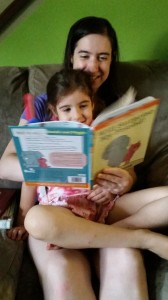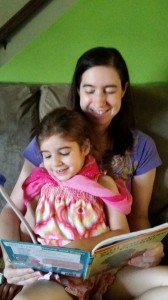A Literature-Based Education: Reading Aloud – Making it Happen
August 12, 2014
 This is Part 2 in the Literature-based Education series. Last week we talked about Choosing Great Literature. Today I’m going to talk about the mechanics of reading aloud.
This is Part 2 in the Literature-based Education series. Last week we talked about Choosing Great Literature. Today I’m going to talk about the mechanics of reading aloud.
So now you’ve chosen a topic to study and you’ve gathered all your books. Now, what exactly does teaching with literature look like? How can you fit all of that reading aloud into your day? It might appear to be a lot of work for the parent, and it is. I’m not going to lie, there is no way around it, this is not hands off homeschooling. But it doesn’t have to be difficult. There is a method to the madness.
I spend the bulk of my day reading with my children. We are immersed in literature as a family – it has become our lifestyle. I break it up throughout the day, but I probably spend a good 3 hours each day reading with my kids. In this way I can introduce literature that they may not choose on their own, whether it’s classics like Tom Sawyer or dystopian literature like The Hunger Games. I read aloud their history and science lessons so that we can discuss them together as we read, and I try to read poetry aloud a few times a week. Some years we even manage to fit in a Shakespeare play. We have a beautiful rhythm of reading to shape our days.
It can be tricky to figure out how to fit in all of that reading in a typical day. Sometimes the day just gets away from you and suddenly its bedtime and you realized you didn’t read aloud at all. It took me a few years to figure out how to make it work. Years ago, I read on a Charlotte Mason message board this idea about pegs – pegging things that you want to make happen onto events that always happen. For example, you’re going to eat meals together at least twice a day, every day. So peg a reading session to a meal – poetry with breakfast, or history at lunch. You could peg your current read aloud novel to bedtime.
It doesn’t have to be one huge chunk of reading – if you tried that you would likely go hoarse! Breaking it up over the course of the day not only makes it more doable, it keeps everyone’s mind fresh. It’s difficult, though, for some children to sit still and stay focused for more than 20 – 30 minutes. They start to fidget, their minds wander, and before you know it, they haven’t heard a single word you’ve said.
Spreading out your readings ensures that they are able to focus on their lessons. It’s another one of Charlotte Mason’s wonderful ideas – short lessons help children to keep their focus. When you’re reading aloud it’s so important for them to be able to give their full attention. We don’t want to make it difficult by dragging on and on for hours. I try to keep a reading session to no more than 45 minutes, unless they are really into it and ask me to read longer. We once read about 4 long chapters of Harry Potter and the Deathly Hallows in a sitting – we read the whole book in about 2 weeks, because they just had to know how it was going to end!
Even so, sometimes it can be difficult – especially if this is something new to your family – to get your child to sit still and listen to a whole chapter, even a short one. Some tips I can give you is to start reading aloud after a session of outside time – let them run around the yard, jump on the trampoline, take a nature walk, do something that might tire them out a bit so that they aren’t quite as antsy during reading time.
Another thing that I find helps with my twins is to let them draw while they listen. They can draw whatever they like, it doesn’t have to have anything to do with what we’re reading, but it keeps their hands busy and their minds focused. An alternative to that is playing with clay or silly putty. Just find anything to keep those hands busy and their mind focused.
 And what about the babies and toddlers? It’s certainly not easy, but still completely doable. When my youngest was a baby, I made sure she took at least one good nap each day and we squeezed a lot of reading time in during her nap. When she stopped napping, I gave her crayons and paper to draw. Or we got out the play-doh or blocks and she played while we read. Having a special basket of “reading-time-only” toys can be a lifesaver. And she gleaned a lot from those readings! Sometimes I’ll hear her talk about Harry Potter or Bilbo Baggins while she’s playing with her toys. She may not remember much about the plot, but she’s definitely still listening.
And what about the babies and toddlers? It’s certainly not easy, but still completely doable. When my youngest was a baby, I made sure she took at least one good nap each day and we squeezed a lot of reading time in during her nap. When she stopped napping, I gave her crayons and paper to draw. Or we got out the play-doh or blocks and she played while we read. Having a special basket of “reading-time-only” toys can be a lifesaver. And she gleaned a lot from those readings! Sometimes I’ll hear her talk about Harry Potter or Bilbo Baggins while she’s playing with her toys. She may not remember much about the plot, but she’s definitely still listening.
I love the idea that she’s growing up within a culture of reading. And of course I read aloud to her books at her level as well. She gets her own special time where we can sit and read picture books, some that I have chosen and some that she chooses herself. Start them young! A child who grows up around books will grow up to be a reader.
There are so many fantastic quality picture books to enjoy with your babies and toddlers. And sometimes I will choose a read aloud that I think the whole family will enjoy so that I can include everyone. Everyone got into the Harry Potter series and The Hobbit. From the youngest (who was just 4 at the time, but still runs around trying to stun her siblings with a wand while riding around on her child sized broom) to the oldest.
And what about mom? If you aren’t used to reading aloud, it can be really hard to go from a picture book or two at bedtime to reading for 2 – 3 hours of your day. Make friends with throat drops and drink plenty of water. This will help keep you from losing your voice. This will sound odd, but be sure you are sitting with good posture. If you aren’t breathing properly, your voice will not hold out for a very long reading session.
Also, ease yourself into it. Don’t try to read a meaty history text, a difficult work of literature, a biography about scientist, and a poetry collection all at once. You’ll burn yourself out before you start! Instead, start with an easy, short chapter book like The Courage of Sarah Noble or My Father’s Dragon
, add in a fun poetry book (I love Shel Silverstein’s works (A Light in the Attic
or Where the Sidewalk Ends
) for beginning poetry), and then, once everyone is used to the idea of reading aloud, you can start adding more.
I once heard someone say that you can always make time for what is important to you. Though there are days when it seems impossible, if reading aloud to your child is your goal then you can find a way to make it happen. Reading aloud can and should be the best part of your day. It is a legacy that you will leave behind for your children. My oldest is already planning out which books she’s going to be taking with her when she starts her own family so that she can read them to her children. To me, that’s worth more to me than gold.
Related Article(s):
- A Literature-Based Education: Teaching Academics
- A Literature-Based Education: Reading Aloud – Making it Happen
- A Literature-Based Education: Choosing Great Literature
- Literature-Based Learning: Creating a Rhythm to your Days
See Also:
A Literary Education: Adapting Charlotte Mason for Modern Secular Homeschooling (Paperback)
 Emily Cook is the author and creator of the secular homeschool curriculum Build Your Library, a literature-based K-12 program infused with the teachings of Charlotte Mason. She writes full year lesson plans as well as shorter topical unit studies. Emily has been homeschooling her four children in Southern NH for 21 years. She is passionate about reading aloud to children of all ages and loves to share her love of literature with others. She and her family also makes incredibly dorky videos about homeschooling, books and more on Youtube at ARRRGH! Schooling. You can follow her on Facebook, Twitter and Pinterest.
Emily Cook is the author and creator of the secular homeschool curriculum Build Your Library, a literature-based K-12 program infused with the teachings of Charlotte Mason. She writes full year lesson plans as well as shorter topical unit studies. Emily has been homeschooling her four children in Southern NH for 21 years. She is passionate about reading aloud to children of all ages and loves to share her love of literature with others. She and her family also makes incredibly dorky videos about homeschooling, books and more on Youtube at ARRRGH! Schooling. You can follow her on Facebook, Twitter and Pinterest.
We’ve been doing a chapter (or two!) out of our main read aloud every night as our bedtime reading. If you add read alouds during meal times, when does mom get to eat? Enquiring minds want to know!
When I read during meals, I usually either eat quickly before I read, or I eat right after. 🙂
I get one audio book at a time to save my voice and we listen to that while we eat.